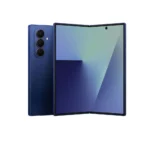Samsung unveiled its thinnest foldable smartphones at Galaxy Unpacked 2025 in Brooklyn on July 9, introducing the Galaxy Z Fold 7 and Galaxy Z Flip 7 with enhanced artificial intelligence capabilities and redesigned form factors.
The Galaxy Z Fold 7, priced at $1,999, is Samsung’s slimmest foldable to date at 4.2mm when unfolded and 8.9mm when folded. The Z Flip 7 maintains the same $1,099 price point as its predecessor, representing Samsung’s efforts to avoid pricing increases that could hinder adoption of foldable technology.
Both devices feature the Qualcomm Snapdragon 8 Elite processor, with the Z Fold 7 sporting a 200MP main camera for the first time in Samsung’s foldable lineup. However, Samsung eliminated S Pen support from the Z Fold 7 to achieve its ultra-thin profile, a move that may disappoint productivity-focused users.
The Z Flip 7 features significant upgrades including a larger 4.1-inch cover screen that spans edge-to-edge, up from the previous 3.4-inch display, and an expanded 6.9-inch main display. Battery capacity increases to 4,300mAh, the largest ever in a Galaxy Flip device.
Samsung is using its own Exynos 2500 processor in the Z Flip 7 for the first time in a foldable device, marking a departure from relying solely on Qualcomm chips. This strategic shift could help Samsung reduce component costs but raises questions about performance consistency across markets.
Both phones ship with One UI 8 based on Android 16, making them among the first devices to launch with Google’s latest mobile operating system. The software emphasizes Galaxy AI features designed to enhance productivity and user experience on larger foldable displays.
Samsung maintains its dominant position in the foldable market, though faces increasing competition from Chinese manufacturers offering thinner designs and larger batteries. Preorders begin immediately with retail availability starting July 25, as Samsung seeks to capitalize on summer demand before competitors announce their own foldable devices later this year.
The company’s ability to maintain pricing while improving hardware specifications suggests confidence in foldable market growth, though eliminating popular features like S Pen support may test consumer acceptance of the trade-offs required for ultra-thin designs.





